
|
[Main Tabs]
[Table of Contents - 6500]
[Index]
[Previous Page]
[Next Page]
[Search]
6500 - Consumer Protection
Appendix H to Part 226—Closed-End Model Forms And Clauses
H--1--Credit Sale Model Form (§ 226.18)
H--2--Loan Model Form (§ 226.18)
H--3--Amount Financed Itemization Model Form (§ 226.18(c))
H--4(A)--Variable-Rate Model Clauses (§ 226.18(f)(1))
H--4(B)--Variable-Rate Model Clauses (§ 226.18(f)(2))
H--4(C)--Variable-Rate Model Clauses (§ 226.19(b))
H--4(D)--Variable-Rate Model Clauses (§ 226.20(c))
H--5--Demand Feature Model Clauses (§ 226.18(I))
H--6--Assumption Policy Model Clause (§ 226.18(q))
H--7--Required Deposit Model Clause (§ 226.18(r))
H--8--Rescission Model Form (General) (§ 226.23)
H--9--Rescission Model Form (Refinancing with Original Creditor)
(§ 226.23)
H--10--Credit Sale Sample
H--11--Installment Loan Sample
H--12--Refinancing Sample
{{10-31-96 p.6678.13}}
H--13--Mortgage with Demand Feature Sample
H--14--Variable Rate Mortgage Sample (§ 226.19(b))
H--15--Graduated Payment Mortgage Sample
H--16--Mortgage Sample (§ 226.32)
{{10-31-96 p.6678.14}}
H–1—CREDIT SALE MODEL
FORM
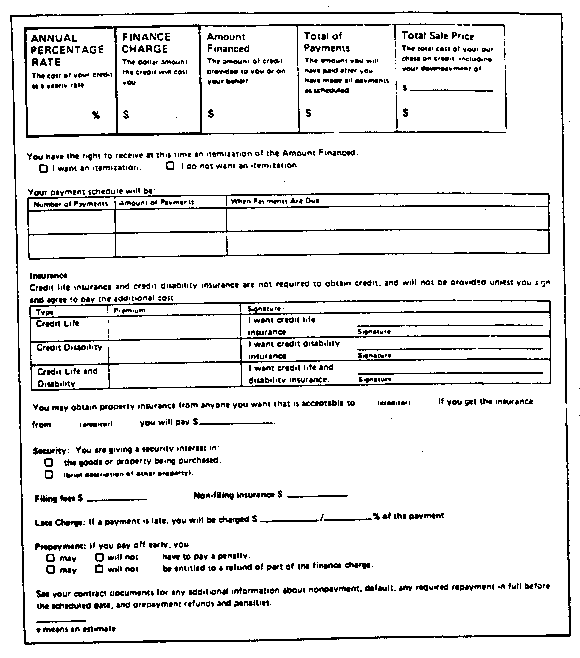
{{6-30-89 p.6678.15}}
H–2—LOAN MODEL
FORM

{{6-30-89 p.6678.16}}
H–3—AMOUNT FINANCED ITEMIZATION MODEL FORM
Itemization of the Amount Financed of $ _______
$ _______ Amount given to you directly
$ _______ Amount paid on your account
Amount paid to others on your behalf
$ _______ to [public officials] [credit bureau]
[appraiser] [insurance company]
$ _______ to [name of another creditor]
$ _______ to (other)
$ _______ Prepaid finance charge
H–4(A)—VARIABLE RATE MODEL CLAUSES
The annual percentage rate may increase during the term of this
transaction if:
[the prime interest rate of (creditor) increases.]
[the balance in your deposit account falls below
$ _______ .]
[you terminate your employment with (employer) .]
[The interest rate will not increase above
_______ %.]
[The maximum interest rate increase at one time will
be _______ %.]
[The rate will not increase more than once every (time
period) .]
Any increase will take the form of:
[higher payment amounts.]
[more payments of the same amount.]
[a larger amount due at maturity.]
Example based on the specific transaction
[If the interest rate increases by _______ % in (time
period),
[your regular payments will increase to $ _______ .]
[you will have to make _______ additional payments.]
[your final payment will increase to $ _______ .]]
Example based on a typical transaction
[If your loan were for $ _______ at _______ %
for (term) and the rate increased to _______ % in (time
period),
[your regular payments would increase by $ _______ .]
[you would have to make _______ additional payments.]
[your final payment would increase by $ _______ .]]
H–4(B) VARIABLE-RATE MODEL CLAUSES
Your loan contains a variable-rate feature. Disclosures about the
variable-rate feature have been provided to you earlier.
H–4(C) VARIABLE-RATE MODEL CLAUSES
This disclosure describes the features of the Adjustable Rate
Mortgage (ARM) program you are considering. Information on other ARM
programs is available upon request.
How Your Interest Rate and Payment are Determined
• Your interest rate will be based on [an index plus a
margin] [a formula].
{{12-31-97 p.6678.17}}
• Your payment will be based on the interest rate, loan balance,
and loan term.
--[The interest rate will be based on (identification of index)
plus our margin. Ask for our current interest rate and margin.]
--[The interest rate will be based on (identification of
formula). Ask us for our current interest rate.]
--Information about the index [formula for rate adjustments] is
published [can be found] _______ .
--[The initial interest rate is not based on the (index)
(formula) used to make later adjustments. Ask us for the amount of
current interest rate discounts.]
How Your Interest Rate Can Change
• Your interest rate can change (frequency).
• [Your interest rate cannot increase or decrease more than
_______ percentage points at each adjustment.]
• Your interest rate cannot increase [or decrease] more than
_______ percentage points over the term of the loan.
How Your Payment Can Change
• Your payment can change (frequency) based on changes
in the interest rate.
• [Your payment cannot increase more than (amount or percentage)
at each adjustment.]
• You will be notified in writing _______ days before the
due date of a payment at a new level. This notice will contain
information about your interest rates, payment amount, and loan
balance.
• [You will be notified once each year during which interest
rate adjustments, but no payment adjustments, have been made to your
loan. This notice will contain information about your interest rates,
payment amount, and loan balance.]
• [For example, on a $10,000 [term] loan with an initial
interest rate of _______ [(the rate shown in the interest rate
column below for the year 19 _______)] [(in effect (month)
(year)], the maximum amount that the interest rate can rise under this
program is _______ percentage points, to _______ %, and
the monthly payment can rise from a first-year payment of
$ _______ to a maximum of $ _______ in the
_______ year. To see what your payments would be, divide your
mortgage amount by $10,000; then multiply the monthly payment by that
amount. (For example, the monthly payment for a mortgage amount of
$60,000 would be: $60,000 + $10,000 = 6; 6 × _______ =
$ _______ per month.)]
Example
The example below shows how your payments would have
changed under this ARM program based on actual changes in the index
from 1982 to 1996. This does not necessarily indicate how your index
will change in the future.
The example is based on the following assumptions:
Amount of loan$10,000
Term_______
Change date_______
Payment adjustment(frequency)
Interest adjustment(frequency)
[Margin] *
_______
Caps _______ [periodic interest rate cap]
_______ [lifetime interest rate cap]
_______ [payment cap] [Interest rate carryover]--
[Negative amortization] [Interest rate
discount] **
Index(identification of index or formula)
{{12-31-97 p.6678.18}}
| Year |
Index (%) |
Margin (percentage points) |
Interest
rate (%) |
Monthly payment ($) |
Remaining balance ($)
|
|---|
| 1982 |
|
|
|
|
|
| 1983 |
|
|
|
|
|
| 1984 |
|
|
|
|
|
| 1985 |
|
|
|
|
|
| 1986 |
|
|
|
|
|
| 1987 |
|
|
|
|
|
| 1988 |
|
|
|
|
|
| 1989 |
|
|
|
|
|
| 1990 |
|
|
|
|
|
| 1991 |
|
|
|
|
|
| 1992 |
|
|
|
|
|
| 1993 |
|
|
|
|
|
| 1994 |
|
|
|
|
|
| 1995 |
|
|
|
|
|
| 1996 |
|
|
|
|
|
Note: To see what your payments would have been during that
period, divide your mortgage amount by $10,000; then multiply the
monthly payment by that amount. (For example, in 1996 the monthly
payment for a mortgage amount of $60,000 taken out in 1982 would be:
$60,000+$10,000=6; 6× _______ = $_______ per month.)
H-4(D) VARIABLE-RATE MODEL CLAUSES
Your new interest rate will be _______ %, which is based on an
index value of _______ %.
Your previous interest rate was _______ %, which was based
on an index value of _______ %.
[The new interest rate does not reflect a change of
_______ percentage points in the index value which was not added
because of _______ .]
[The new payment will be $ _______ .]
[Your new loan balance is $ _______ .]
[Your (new) (existing) payment will not be sufficient to cover the
interest due and the difference will be added to the loan amount. The
payment amount needed to pay your loan in full by the end of the term
at the new interest rate is $ _______ .]
[The following interest rate adjustments have been implemented this
year without changing your payment: _______ . These interest
rates were based on the following index values: _______ .]
H-5—DEMAND FEATURE MODEL CLAUSES
This obligation [is payable on demand.] [has a demand
feature.]
[All disclosures are based on an assumed maturity of one year.]
H-6—ASSUMPTION POLICY MODEL CLAUSE
Assumption: Someone buying your house [may, subject to conditions,
be allowed to] [cannot] assume the remainder of the mortgage on the
original terms.
H-7—REQUIRED DEPOSIT MODEL CLAUSE
The annual percentage rate does not take into account your required
deposit.
{{10-31-96 p.6678.19}}
H–8—RESCISSION MODEL FORM (GENERAL)
NOTICE OF RIGHT TO CANCEL
Your Right to Cancel
You are entering into a transaction that will result in a
[mortgage/lien/security interest] [on/in] your home. You have a
legal right under federal law to cancel this transaction, without cost,
within three business days from whichever of the following events
occurs last:
(1) the date of the transaction, which is _______ ;
or
(2) the date you received your Truth in Lending disclosures;
or
(3) the date you received this notice of your right to
cancel.
If you cancel the transaction, the [mortgage/lien/security
interest] is also cancelled. Within 20 calendar days after we receive
your notice, we must take the steps necessary to reflect the fact that
the [mortgage/lien/security interest] [on/in] your home has been
cancelled, and we must return to you any money or property you have
given to us or to anyone else in connection with this transaction.
You may keep any money or property we have given you until we have
done the things mentioned above, but you must then offer to return the
money or property. If it is impractical or unfair for you to return the
property, you must offer its reasonable value. You may offer to return
the property at your home or at the location of the property. Money
must be returned to the address below. If we do not take possession of
the money or property within 20 calendar days of your offer, you may
keep it without further obligation.
How to Cancel
If you decide to cancel this transaction, you may do so by
notifying us in writing, at
(creditor's name and business address).
You may use any written statement that is signed and dated by you
and states your intention to cancel, or you may use this notice by
dating and signing below. Keep one copy of this notice because it
contains important information about your rights.
If you cancel by mail or telegram, you must send the notice no
later than midnight of (date) (or midnight of the
third business day following the latest of the three events listed
above). If you send or deliver your written notice to cancel some other
way, it must be delivered to the above address no later than that time.
I WISH TO CANCEL
_______ _______
Consumer's Signature Date
H–9—RESCISSION MODEL FORM (REFINANCING WITH
ORIGINAL CREDITOR)
NOTICE OF RIGHT TO CANCEL
Your Right to Cancel
You are entering into a new transaction to increase the
amount of credit previously provided to you. Your home is the security
for this new transaction. You have a legal right under federal law to
cancel this new transaction, without cost, within three business days
from whichever of the following events occurs last:
(1) the date of this new transaction, which is _______ ; or
(2) the date you received your new Truth in Lending disclosures;
or
(3) the date you received this notice of your right to cancel.
If you cancel this new transaction, it will not affect any amount
that you presently owe. Your home is the security for that amount.
Within 20 calendar days after we receive your notice of cancellation of
this new transaction, we must take the steps necessary to reflect the
fact that your home does not secure the increase of credit. We must
also return any money you have given to us or anyone else in connection
with this new transaction.
You may keep any money we have given you in this new transaction
until we have done the things mentioned above, but you
{{10-31-96 p.6678.20}}must then offer to return the money at
the address below.
If we do not take possession of the money within 20 calendar days of
your offer, you may keep it without further obligation.
How To Cancel
If you decide to cancel this new transaction, you may do so by
notifying us in writing, at
____________________________________________ (Creditor's name and business address).
You may use any written statement that is signed and dated by
you and state your intention to cancel, or you may use this notice by
dating and signing below. Keep one copy of this notice because it
contains important information about your rights.
If you cancel by mail or telegram, you must send the notice no later
than midnight of
____________________________________________ (Date) ____________________________________________
(or midnight of the third business day following the latest of the
three events listed above).
If you send or deliver your written notice to cancel some other way,
it must be delivered to the above address no later than that time.
I WISH TO CANCEL
____________________________________________ Consumer's Signature
____________________________________________ Date
{{6-30-89 p.6678.21}}
H–10—CREDIT SALE
SAMPLE
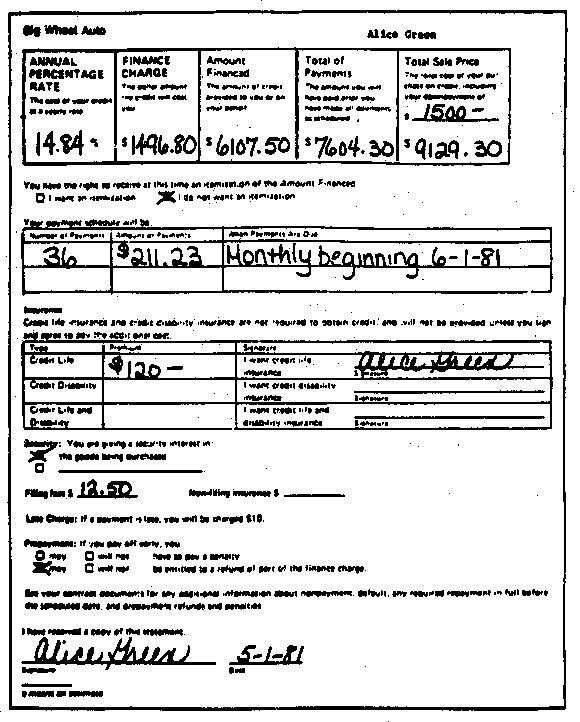
{{6-30-89 p.6678.22}}
H–11—INSTALLMENT LOAN
SAMPLE
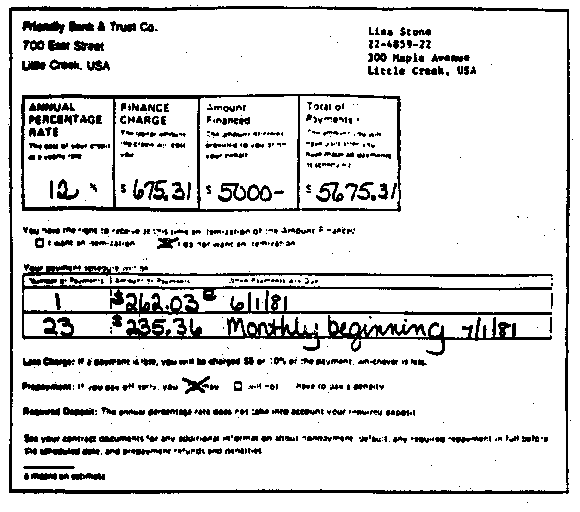
{{6-30-89 p.6678.23}}
H–12—REFINANCING
SAMPLE
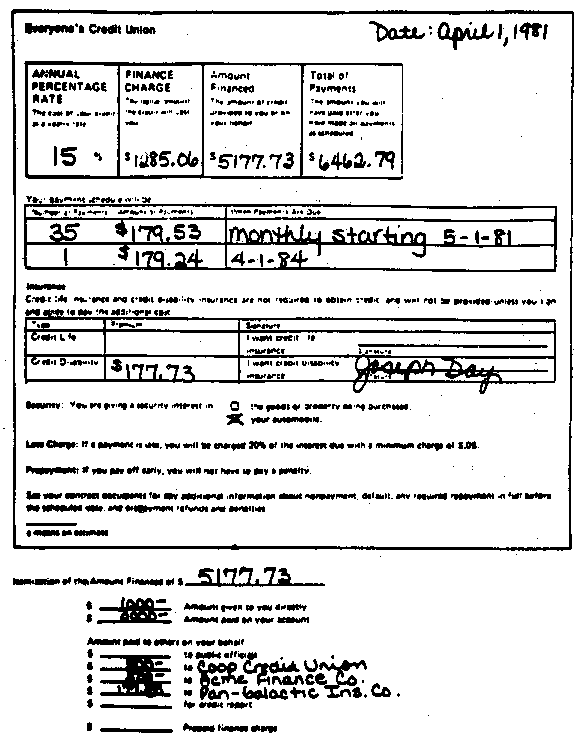
{{6-30-89 p.6678.24}}
H–13—MORTGAGE WITH DEMAND FEATURE
SAMPLE
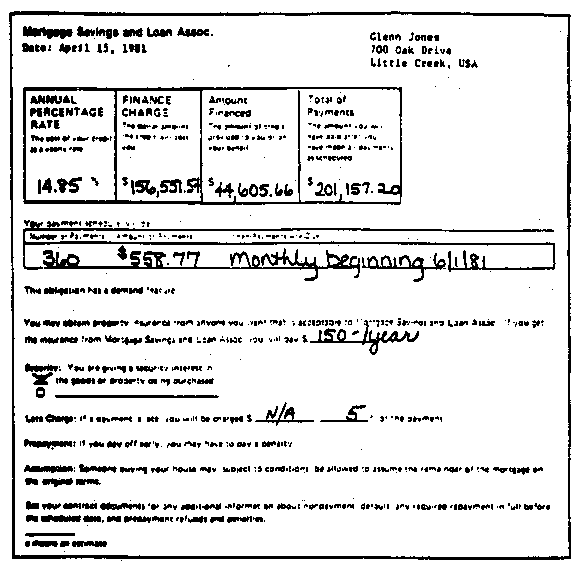
{{12-31-97 p.6678.25}}
H-14—VARIABLE RATE MORTGAGE SAMPLE
This disclosure describes the features of the adjustable rate
mortgage (ARM) program you are considering. Information on other ARM
programs is available upon request.
How Your Interest Rate and Payment are Determined
• Your interest rate will be based on an index rate plus a
margin.
• Your payment will be based on the interest rate, loan balance,
and loan term.
--The interest rate will be based on the weekly average yield on
United States Treasury securities adjusted to a constant maturity of 1
year (your index), plus our margin. Ask us for our current interest
rate and margin.
--Information about the index rate is published weekly in the Wall
Street Journal.
• Your interest rate will equal the index rate plus our margin
unless your interest rate ``caps'' limit the amount of change in the
interest rate.
How Your Interest Rate Can Change
• Your interest rate can change yearly.
• Your interest rate cannot increase or decrease more than 2
percentage points per year.
• Your interest rate cannot increase or decrease more than 5
percentage points over the term of the loan.
How Your Monthly Payment Can Change
• Your monthly payment can increase or decrease substantially
based on annual changes in the interest rate.
• [For example, on a $10,000, 30-year loan with an initial
interest rate of 12.41 percent in effect in July 1996, the maximum
amount that the interest rate can rise under this program is 5
percentage points, to 17.41 percent, and the monthly payment can rise
from a first-year payment of $106.03 to a maximum of $145.34 in the
fourth year. To see what your payment is, divide your mortgage amount
by $10,000; then multiply the monthly payment by that amount. (For
example, the monthly payment for a mortgage amount of $60,000 would be:
$60,000$10,000=6; 6×106.03=$636.18 per month.)
• You will be notified in writing 25 days before the annual
payment adjustment may be made. This notice will contain information
about your interest rates, payment amount and loan balance.]
Example
The example below shows how your payments would have changed under
this ARM program based on actual changes in the index from 1982 to
1996. This does not necessarily indicate how your index will change in
the future. The example is based on the following
assumptions:
| Amount |
$10,000 |
|---|
| Term |
30 years |
| Payment
adjustment |
1 year |
| Interest adjustment |
1 year
|
| Margin |
3 percentage points
|
Caps _______ 2 percentage points annual interest rate
_______ 5 percentage points lifetime interest
rate Index _______ Weekly average yield on U.S. Treasury
securities adjusted to a constant maturity of one year.
{{12-31-97 p.6678.26}}
| Year(as of 1st week ending in July) |
Index (%) |
Margin*
(percentage points) |
Interest Rate (%) |
Monthly
Payment ($) |
Remaining Balance ($)
|
|---|
| 1982 |
14.41 |
3 |
17.41 |
145.90 |
9,989.37
|
| 1983 |
9.78 |
3 |
**15.41 |
129.81 |
9,969.66
|
| 1984 |
12.17 |
3 |
15.17 |
127.91 |
9,945.51
|
| 1985 |
7.66 |
3 |
**13.17 |
112.43 |
9,903.70
|
| 1986 |
6.36 |
3 |
***12.41 |
106.73 |
9,848.94
|
| 1987 |
6.71 |
3 |
***12.41 |
106.73 |
9,786.98
|
| 1988 |
7.52 |
3 |
***12.41 |
106.73 |
9,716.88
|
| 1989 |
7.97 |
3 |
***12.41 |
106.73 |
9,637.56
|
| 1990 |
8.06 |
3 |
***12.41 |
106.73 |
9,547.83
|
| 1991 |
6.40 |
3 |
***12.41 |
106.73 |
9,446.29
|
| 1992 |
3.96 |
3 |
***12.41 |
106.73 |
9,331.56
|
| 1993 |
3.42 |
3 |
***12.41 |
106.73 |
9,201.61
|
| 1994 |
5.47 |
3 |
***12.41 |
106.73 |
9,054.72
|
| 1995 |
5.53 |
3 |
***12.41 |
106.73 |
8,888.52
|
| 1996 |
5.82 |
3 |
***12.41 |
106.73 |
8,700.37
|
*This is a margin we have used recently; your margin may be
different.
**This interest rate reflects a 2 percentage point annual interest
rate cap.
***This interest rate reflects a 5 percentage point lifetime
interest rate cap.
Note: To see what your payments would have been during that period,
divide your mortgage amount by $10,000; then multiply the monthly
payment by that amount. (For example, in 1996 the monthly payment for a
mortgage amount of $60,000 taken out in 1982 would be:
$60,000$10,000=6; 6×$106.73=$640.38.)
• You will be notified in writing 25 days before the
annual payment adjustment may be made. This notice will contain
information about your interest rates, payment amount and loan
balance.]
{{12-31-07 p.6678.27}}
H–15—GRADUATED PAYMENT MORTGAGE
SAMPLE
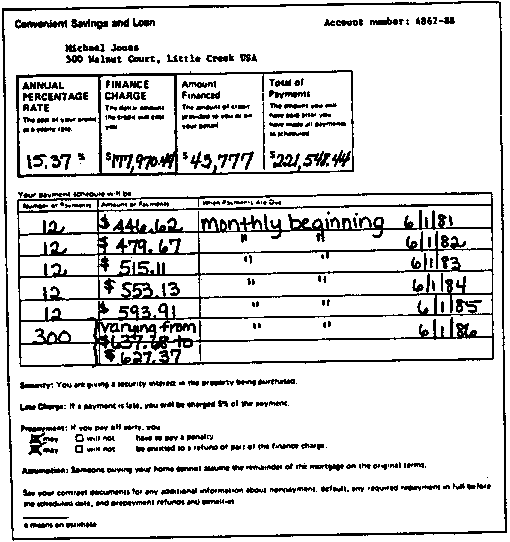
H–16—MORTGAGE
SAMPLE
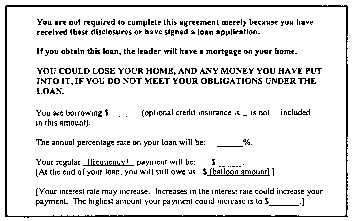
{{12-31-07 p.6678.28}}
[Codified to 12 C.F.R. Part 226, Appendix H]
[Apendix H amended at 46 Fed. Reg. 29246, June 1,
1981; 52 Fed. Reg. 48672, December 24, 1987, effective December 28,
1987, but compliance optional until October 1, 1988; 53 Fed. Reg. 467,
January 7, 1988; 60 Fed. Reg. 15473, March 24, 1995, effective March
22, 1995, compliance optional until October 1, 1995; 61 Fed. Reg.
49247, September 19, 1996, effective October 21, 1996; 62 Fed. Reg.
63444, December 1, 1997, effective October 23, 1997; 66 Fed. Reg.
65618, December 20, 2001, effective December 20, 2001, but compliance
mandatory as of October 1, 2002]
Appendix I—Federal Enforcement Agencies
The following list indicates which federal agency enforces
Regulation Z for particular classes of businesses. Any questions
concerning compliance by a particular business should be directed to
the appropriate enforcement agency. Terms that are not defined in the
Federal Deposit Insurance Act (12
U.S.C. 1813(s) shall have the meaning given to them in the
International Banking Act of 1978 (12
U.S.C. 3101).
National banks and federal branches and federal agencies of
foreign banks
District office of the Office of the Comptroller of the Currency for
the district in which the institution is located.
State member banks, branches and agencies of foreign banks (other
than federal branches, federal agencies, and insured state branches of
foreign banks), commercial lending companies owned or controlled by
foreign banks, and organizations operating under section 25 or 25A of
the Federal Reserve Act.
Federal Reserve bank serving the district in which the institution
is located.
Nonmember insured banks and insured state branches of foreign
banks
Federal Deposit Insurance Corporation regional director for the
region in which the institution is located.
Savings institutions insured under the Savings
Association Insurance Fund of the FDIC and federally chartered savings
banks insured under the Bank Insurance Fund of the FDIC (but not
including state-chartered savings banks insured under the Bank
Insurance Fund).
Office of Thrift Supervision Regional Director for the region in
which the institution is located.
Federal Credit Unions
Regional office of the National Credit Union Administration serving
the area in which the federal credit union is located.
Air Carriers
Assistant General Counsel for Aviation Enforcement and Proceedings
Department of Transportation 400 Seventh Street, S.W. Washington,
D.C. 20590
Creditors Subject to Packers and Stockyards Act
Nearest Packers and Stockyards Administration area supervisor.
Federal Land Banks, Federal Land Bank Associations, Federal
Intermediate Credit Banks and Production Credit Associations
Farm Credit Administration 490 L'Enfant Plaza, S. W.
Washington, D.C. 20578
{{12-31-01 p.6678.28-A}}
Retail, Department Stores, Consumer Finance Companies, All Other
Creditors, and All Nonbank Credit Card Issuers (Creditors
operating on a local or regional basis should use the address of the
FTC Regional Office in which they operate.)
Division of Credit Practices Bureau of Consumer
Protection Federal Trade Commission Washington, D.C. 20580
[Codified to 12 C.F.R. Part 226, Appendix I]
[Appendix I amended at 50 Fed. Reg. 8708, March 5, 1985,
effective March 4, 1985; 54 Fed. Reg. 53539, December 29, 1989; 57 Fed.
Reg. 20400, May 13, 1992]
{{6-30-92 p.6678.29}}
Appendix J—Annual Percentage Rate Computations For
Closed-End
Credit Transactions
(a) Introduction. (1) Section
226.22(a) of Regulation Z provides that the annual percentage
rate for other than open end credit transactions shall be determined in
accordance with either the actuarial method or the United States Rule
method. This appendix contains an explanation of the actuarial method
as well as equations, instructions and examples of how this method
applies to single advance and multiple advance transactions.
(2) Under the actuarial method, at the end of each unit-period
(or fractional unit-period) the unpaid balance of the amount financed
is increased by the finance charge earned during that period and is
decreased by the total payment (if any) made at the end of that period.
The determination of unit-periods and fractional unit-periods shall be
consistent with the definitions and rules in paragraphs (b)(3), (4) and
(5) of this section and the general equation in paragraph (b)(8) of
this section.
(3) In contrast, under the United States Rule method, at the end
of each payment period, the unpaid balance of the amount financed is
increased by the finance charge earned during that payment period and
is decreased by the payment made at the end of that payment period. If
the payment is less than the finance charge earned, the adjustment of
the unpaid balance of the amount financed is postponed until the end of
the next payment period. If at that time the sum of the two payments is
still less than the total earned finance charge for the two payment
periods, the adjustment of the unpaid balance of the amount financed is
postponed still another payment period, and so forth.
(b) Instructions and equations for the actuarial
method. (1) General rule. The annual percentage rate
shall be the nominal annual percentage rate determined by multiplying
the unit-period rate by the number of unit-periods in a year.
(2) Term of the transaction. The term of the
transaction begins on the date of its consummation, except that if the
finance charge or any portion of it is earned beginning on a later
date, the term begins on the later date. The term ends on the date the
last payment is due, except that if an advance is scheduled after that
date, the term ends on the later date. For computation purposes, the
length of the term shall be equal to the time interval between any
point in time on the beginning date to the same point in time on the
ending date.
(3) Definitions of time intervals. (i) A period is
the interval of time between advances or between payments and includes
the interval of time between the date the finance charge begins to be
earned and the date of the first advance thereafter or the date of the
first payment thereafter, as applicable.
(ii) A common period is any period that occurs more than once in
a transaction.
(iii) A standard interval of time is a day, week, semimonth,
month, or a multiple of a week or a month up to, but not exceeding, 1
year.
(iv) All months shall be considered equal. Full months shall be
measured from any point in time on a given date of a given month to the
same point in time on the same date of another month. If a series of
payments (or advances) is scheduled for the last day of each month,
months shall be measured from the last day of the given month to the
last day of another month. If payments (or advances) are scheduled for
the 29th or 30th of each month, the last day of February shall be used
when applicable.
(4) Unit-period. (i) In all transactions other than
a single advance, single payment transaction, the unit-period shall be
that common period, not to exceed 1 year, that occurs most frequently
in the transaction, except that
(A) If 2 or more common periods occur with equal frequency, the
smaller of such common periods shall be the unit-period; or
(B) If there is no common period in the transaction, the
unit-period shall be that period which is the average of all periods
rounded to the nearest whole standard interval of time. If the average
is equally near 2 standard intervals of time, the lower shall be the
unit-period.
(ii) In a single advance, single payment transaction, the
unit-period shall be the term of the transaction, but shall not exceed
1 year.
{{6-30-92 p.6678.30}}
(5) Number of unit-periods between 2 given
dates. (i) The number of days between 2 dates shall be the
number of 24-hour intervals between any point in time on the first date
to the same point in time on the second date.
(ii) If the unit-period is a month, the number of full
unit-periods between 2 dates shall be the number of months measured
back from the later date. The remaining fraction of a unit-period shall
be the number of days measured forward from the earlier date to the
beginning of the first full unit-period, divided by 30. If the
unit-period is a month, there are 12 unit-periods per year.
(iii) If the unit-period is a semimonth or a multiple of a month
not exceeding 11 months, the number of days between 2 dates shall be 30
times the number of full months measured back from the later date, plus
the number of remaining days. The number of full unit-periods and the
remaining fraction of a unit-period shall be determined by dividing
such number of days by 15 in the case of a semimonthly unit-period or
by the appropriate multiple of 30 in the case of a multimonthly
unit-period. If the unit-period is a semimonth, the number of
unit-periods per year shall be 24. If the number of unit-periods is a
multiple of a month, the number of unit-periods per year shall be 12
divided by the number of months per unit-period.
(iv) If the unit-period is a day, a week, or a multiple of a
week, the number of full unit-periods and the remaining fractions of a
unit-period shall be determined by dividing the number of days between
the 2 given dates by the number of days per unit-period. If the
unit-period is a day, the number of unit-periods per year shall be 365.
If the unit-period is a week or a multiple of a week, the number of
unit-periods per year shall be 52 divided by the number of weeks per
unit-period.
(v) If the unit-period is a year, the number of full unit-periods
between two dates shall be the number of full years (each equal to 12
months) measured back from the later date. The remaining fraction of a
unit-period shall be
(A) The remaining number of months divided by 12 if the
remaining interval is equal to a whole number of months, or
(B) The remaining number of days divided by 365 if the
remaining interval is not equal to a whole number of months.
(vi) In a single advance, single payment transaction in which the
term is less than a year and is equal to a whole number of months, the
number of unit-periods in the term shall be 1, and the number of
unit-periods per year shall be 12 divided by the number of months in
the term or 365 divided by the number of days in the term.
(vii) In a single advance, single payment transaction in which
the term is less than a year and is not equal to a whole
number of months, the number of unit-periods in the term shall be 1,
and the number of unit-periods per year shall be 365 divided by the
number of days in the term.
(6) Percentage rate for a fraction of a
unit-period. The percentage rate of finance charge for a fraction
(less than 1) of a unit-period shall be equal to such fraction
multiplied by the percentage rate of finance charge per unit-period.
(7) Symbols. The symbols used to express the terms of
a transaction in the equation set forth in paragraph (b)(8) of this
section are defined as follows:
Ak = The amount of the kth advance.
qk = The number of full unit-periods from the beginning of
the term of the transaction to the kth advance.
ek = The fraction of a unit-period in the time interval
from the beginning of the term of the transaction to the kth advance.
m = The number of advances.
Pj = The amount of the jth payment.
tj = The number of full unit-periods from the beginning of
the term of the transaction to the jth payment.
fj = The fraction of a unit-perid in the time interval
from the beginning of the term of the transaction to the jth
payment.
{{10-31-07 p.6678.31}}
n = The number of payments.
i = The percentage rate of finance charge per unit-period,
expressed as a decimal equivalent.
Symbols used in the examples shown in this appendix are defined as
follows:

w = The number of unit-periods per year.
I = wi × 100 = The nominal annual percentage rate.
(8) General equation. The following equation
sets forth the relationship among the terms of a
transaction:

(9) Solution of general equation by iteration
process. (i) The general equation in paragraph (b)(8) of this
section, when applied to a simple transaction in which a loan of $1000
is repaid by 36 monthly payments of $33.61 each, takes the special
form:
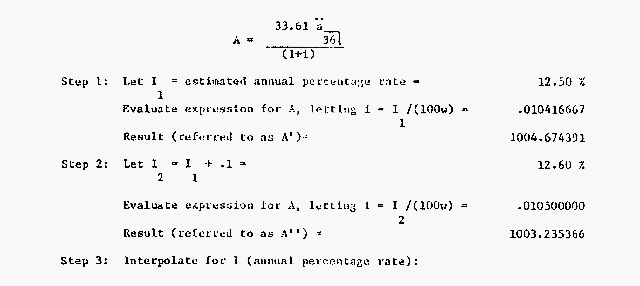
{{10-31-07 p.6678.32}}

In this case, no further iterations are required to obtain
the annual percentage rate correct to two decimal places, 12.83%.
(ii) When the iteration approach is used, it is expected that
calculators or computers will be programmed to carry all available
decimals throughout the calculation and that enough iterations will be
performed to make virtually certain that the annual percentage rate
obtained, when rounded to 2 decimals, is correct. Annual percentage
rates in the examples below were obtained by using a 10 digit
programmable calculator and the iteration procedure described above.
(c) Examples for the actuarial method.
(1) Single advance transaction, with or without an odd first
period, and otherwise regular. The general equation in paragraph
(b)(8) of this section can be put in the following special form for
this type of
transaction:

Example (i): Monthly payments (regular first
period)
Amount advanced (A) = $5000. Payment (P) = $230.
Number of payments (n) = 24.
Unit-period = 1 month. Unit-periods per year (w) = 12.
Advance, 1-10-78. First payment, 2-10-78.
From 1-10-78 through 2-10-78 = 1 unit-period. (t = 1; f = 0)
Annual percentage rate (I) = wi = .0969 = 9.69%
Example (ii): Monthly payments (long first period)
Amount advanced (A) = $6000. Payment (P) = $200.
Number of payments (n) = 36.
Unit-period = 1 month. Unit-periods per year (w) = 12.
Advance, 2-10-78. First payment, 4-1-78.
From 3-1-78 through 4-1-78 = 1 unit-period. (t = 1)
From 2-10-78 through 3-1-78 = 19 days. (f = 19/30)
Annual percentage rate (I) = wi = .1182 = 11.82%
Example (iii): Semimonthly payments (short first period)
Amount advanced (A) = $5000. Payment (P) = $219.17.
Number of payments (n) = 24.
Unit-period = 1/2 month. Unit-periods per year (w) = 24.
Advance, 2-23-78. First payment, 3-1-78. Payments made
on 1st and 16th of each month.
From 2-23-78 through 3-1-78 = 6 days. (t = 0; f = 6/15)
Annual percentage rate (I) = wi = .1034 = 10.34%
Example (iv): Quarterly payments (long first period)
Amount advanced (A) = $10,000. Payment (P) = $385.
Number of payments (n) = 40.
Unit-period = 3 months. Unit-periods per year (w) = 4.
Advance, 5-23-78. First payment, 10-1-78.
{{10-31-07 p.6678.33}}
From 7-1-78 through 10-1-78 = 1 unit-period. (t = 1)
From 6-1-78 through 7-1-78 = 1 month = 30 days. From
5-23-78 through 6-1-78 = 9 days. (f = 39/90)
Annual percentage rate (I) = wi = .0897 = 8.97%
Example (v): Weekly payments (long first period)
Amount advanced (A) = $500. Payment (P) = $17.60.
Number of payments (n) = 30.
Unit-period = 1 week. Unit-periods per year (w) = 52.
Advance, 3-20-78. First payment, 4-21-78.
From 3-24-78 through 4-21-78 = 4 unit-periods. (t = 4)
From 3-20-78 through 3-24-78 = 4 days. (f = 4/7)
Annual percentage rate (I) = wi = .1496 = 14.96%
(2) Single advance transaction, with an odd first payment,
with or without an odd first period, and otherwise regular. The
general equation in paragraph (b)(8) of this section can be put in the
following special form for this type of
transaction:

Example (i): Monthly payments (regular first period and
irregular first payment)
Amount advanced (A) = $5000. First payment (P1) = $250.
Regular payment (P) = $230. Number of payments (n) = 24. Unit-period
= 1 month. Unit-periods per year (w) = 12. Advance, 1-10-78. First
payment, 2-10-78. From 1-10-78 through 2-10-78 = 1 unit-period. (t =
1; f = 0) Annual percentage rate (I) = wi = .1008 = 10.08%
Example (ii): Payments every 4 weeks (long first period
and irregular first payment)
Amount advanced (A) = $400. First payment (P1) = $39.50
Regular payment (P) = $38.31. Number of payments (n) = 12.
Unit-period = 4 weeks. Unit-periods per year (w) = 52/4 = 13.
Advance, 3-18-78. First payment, 4-20-78. From 3-23-78 through
4-20-78 = 1 unit-period. (t = 1) From 3-18-78 through 3-23-78 = 5
days. (f = 5/28) Annual percentage rate (I) = wi = .2850 = 28.50%
(3) Single advance transaction, with an odd final payment,
with or without an odd first period, and otherwise regular. The
general equation in paragraph (b)(8) of this section can be put in the
following special form for this type of
transaction:

Example (i): Monthly payments (regular first period and
irregular final payment)
Amount advanced (A) = $5000. Regular payment (P) = $230. Final
payment (Pa) = $280. Number of payments (n) = 24. Unit-period =
1 month. Unit-periods per year (w) = 12. Advance, 1-10-78. First
payment, 2-10-78
{{10-31-07 p.6678.34}}From 1-10-78 through 2-10-78 = 1
unit-period. (t = 1; f = 0) Annual percentage rate (I) = wi = .1050
= 10.50%
Example (ii): Payments every 2 weeks (short first period
and irregular final payment)
Amount advanced (A) = $200. Regular payment (P) = $9.50. Final
payment (Pa) = $30. Number of payments (n) = 20. Unit-period = 2
weeks. Unit-periods per year (w) = 52/2 = 26. Advance, 4-3-78. First
payment, 4-11-78. From 4-3-78 through 4-11-78 = 8 days. (t = 0; f =
8/14) Annual percentage rate (I) = wi = .1222 = 12.22%
(4) Single advance transaction, with an odd first payment,
odd final payment, with or without an odd first period, and otherwise
regular. The general equation in paragraph (b)(8) of this section
can be put in the following special form for this type of
transaction:

Example (i): Monthly payments (regular first period,
irregular first payment, and irregular final payment)
Amount advanced (A) = $5000. First payment (P1) = $250. Regular
payment (P) = $230. Final payment (Pn) = $280. Number of
payments (n) = 24. Unit-period = 1 month. Unit-periods per year (w)
= 12. Advance, 1-10-78. First payment, 2-10-78. From 1-10-78
through 2-10-78 = 1 unit-period. (t = 1; f = 0) Annual percentage
rate (I) = wi = .1090 = 10.90%
Example (ii): Payments every two months (short first
period, irregular first payment, and irregular final payment)
Amount advanced (A) = $8000. First payment (P1) = $449.36
Regular payment (P) = $465. Final payment (Pn) = $200. Number of
payments (n) = 20. Unit-period = 2 months. Unit-periods per year (w)
= 12/2 = 6. Advance, 1-10-78. First payment, 3-1-78. From 2-1-78
through 3-1-78 = 1 month. From 1-10-78 through 2-1-78 = 22 days. (t
= 0; f = 52/60) Annual percentage rate (I) = wi = .0730 = 7.30%
(5) Single advance, single payment transaction. The
general equation in paragraph (b)(8) of this section can be put in the
special forms below for single advance, single payment transactions.
Forms 1 through 3 are for the direct determination of the annual
percentage rate under special conditions. Form 4 requires the use of
the iteration procedure of paragraph (b)(9) of this section and can be
used for all single advance, single payment transactions regardless of
term.

{{10-31-07 p.6678.35}}
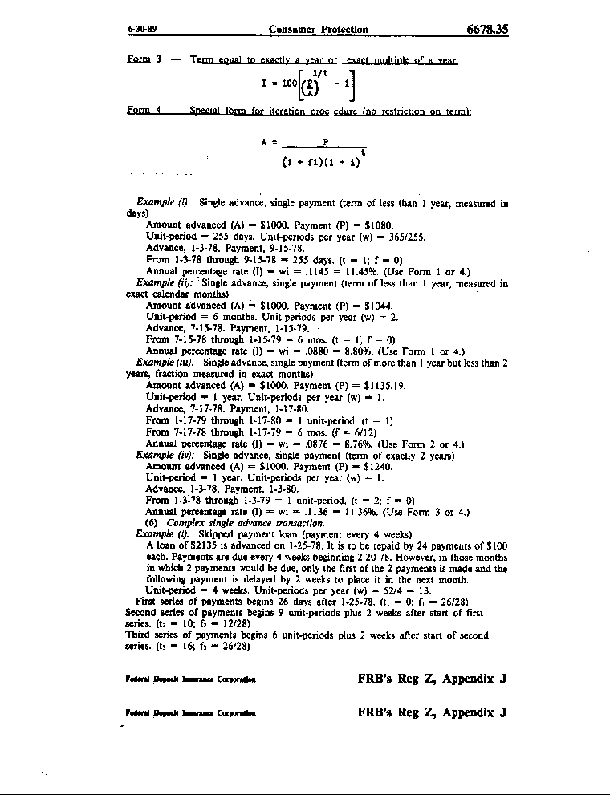
Example (i): Single advance, single payment
(term of less than 1 year, measured in days)
Amount advanced (A) = $1000. Payment (P) = $1080.
Unit-period = 255 days. Unit-periods per year (w) = 365/255.
Advance, 1-3-78. Payment, 9-15-78.
From 1-3-78 through 9-15-78 = 255 days. (t = 1; f = 0)
Annual percentage rate (I) = wi = .1145 = 11.45%. (Use Form 1 or
4.)
Example (ii): Single advance, single payment (term of
less than 1 year, measured in exact calendar months)
Amount advanced (A) = $1000. Payment (P) = $1044.
Unit-period = 6 months. Unit-periods per year (w) = 2.
Advance, 7-15-78. Payment, 1-15-79.
From 7-15-78 through 1-15-79 = 6 mos. (t = 1; f = 0)
Annual percentage rate (I) = wi = .0880 = 8.80%. (Use Form 1 or
4.)
Example (iii): Single advance, single payment (term of
more than 1 year but less than 2 years, fraction measured in exact
months)
Amount advanced (A) = $1000. Payment (P) = $1135.19.
Unit-period = 1 year. Unit-periods per year (w) = 1.
Advance, 7-17-78. Payment, 1-17-80.
From 1-17-79 through 1-17-80 = 1 unit-period. (t = 1)
From 7-17-78 through 1-17-79 = 6 mos. (f = 6/12)
Annual percentage rate (I) = wi = .0876 = 8.76%. (Use Form 2 or
4.)
Example (iv): Single advance, single payment (term of
exactly 2 years)
Amount advanced (A) = $1000. Payment (P) = $1240.
Unit-period = 1 year. Unit-periods per year (w) = 1.
Advance, 1-3-78. Payment, 1-3-80.
From 1-3-78 through 1-3-79 = 1 unit-period. (t = 2; f = 0)
Annual percentage rate (I) = wi = .1136 = 11.36%. (Use Form 3 or
4.)
(6) Complex single advance transaction.
Example (i): Skipped payment loan (payment every 4
weeks)
A loan of $2135 is advanced on 1-25-78. It is to be
repaid by 24 payments of $100 each. Payments are due every 4 weeks
beginning 2-20-78. However, in those months in which 2 payments would
be due, only the first of the 2 payments is made and the following
payment is delayed by 2 weeks to place it in the next month.
Unit-period = 4 weeks. Unit-periods per year (w) = 52/4 = 13.
First series of payments begins 26 days after 1-25-78. (t1 = 0;
f1 = 26/28) Second series of payments begins 9 unit-periods plus
2 weeks after start of first series. (t2 = 10; f2 =
12/28) Third series of payments begins 6 unit-periods plus 2 weeks
after start of second series. (t3 = 16; f3 =
26/28)
{{10-31-07 p.6678.36}}Last series of payments begins 6
unit-periods plus 2 weeks after start of third series. (t4 = 23;
f4 = 12/28)
The general equation in paragraph (b)(8) of this
section can be written in the special
form:

Annual percentage rate (I) = wi = .1200 = 12.00%
Example (ii): Skipped payment loan plus single payments
A loan of $7350 on 3-3-78 is to be repaid by 3 monthly
payments of $1000 each beginning 9-15-78, plus a single payment of
$2000 on 3-15-79, plus 3 more monthly payments of $750 each beginning
9-15-79, plus a final payment of $1000 on 2-1-80.
Unit-period = 1 month. Unit-periods per year (w) = 12. First
series of payments begins 6 unit-periods plus 12 days after 3-3-78.
(t1 = 6; f1 = 12/30) Second series of payments (single
payment) occurs 12 unit-periods plus 12 days after 3-3-78. (t2 =
12; f2 = 12/30) Third series of payments begins 18 unit-periods
plus 12 days after 3-3-78. (t3 = 18; f3 = 12/30) Final
payment occurs 22 unit-periods plus 29 days after 3-3-78. (t4 =
22; f4 = 29/30)
The general equation in paragraph (b)(8) of this section can be
written in the special
form:
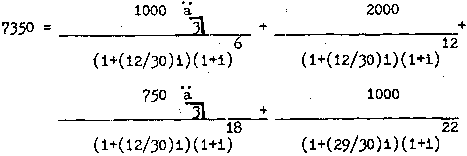
Annual percentage rate (I) = wi = .1022 = 10.22%
Example (iii): Mortgage with varying payments
A loan of $39,688.56 (net) on 4-10-78 is to be repaid
by 360 monthly payments beginning 6-1-78. Payments are the same for 12
months at a time as follows:
{{10-31-07 p.6678.37}}

Unit period = 1 month. Unit-periods per year (w) = 12.
From 5-1-78 through 6-1-78 = 1 unit-period. (t = 1)
From 4-10-78 through 5-1-78 = 21 days. (f = 21/30)
The general equation in paragraph (b)(8) of this
section can be written in the special
form:

Annual percentage rate (I) = wi = .0980 = 9.80%
(7) Multiple advance transactions.
Example (i): Construction loan
Three advances of $20,000 each are made on 4-10-79,
6-12-79, and 9-18-79. Repayment is by 240 monthly payments of $612.36
each beginning 12-10-79.
Unit period + 1 month. Unit-periods per year (w) = 12.
From 4-10-79 through 6-12-79 = (2 + 2/30) unit-periods.
From 4-10-79 through 9-18-79 = (5 + 8/30) unit-periods.
From 4-10-79 through 12-10-79 = (8) unit-periods.
The general equation in paragraph (b)(8) of this
section is changed to the single advance mode by treating the 2nd and
3rd advances as negative
payments:

Annual percentage rate (I) = wi = .1025 = 10.25%
Example (ii): Student loan
A student loan consists of 8 advances: $1800 on 9-5-78,
9-5-79, 9-5-80, and 9-5-81; plus $1000 on 1-5-79, 1-5-80, 1-5-81, and
1-5-82. The borrower is to make 50 monthly payments of $240 each
beginning 7-1-78 (prior to first advance).
{{10-31-07 p.6678.38}}
Unit period = 1 month. Unit-periods per year (w) = 12.
Zero point is date of first payment since it precedes first
advance.
| From |
7-1-78 |
to |
9-]5-78
= (2 + 4/30) |
unit-periods.
|
|---|
| " |
" |
" |
9-]5-79 = (14 + 4/30) |
"
|
| " |
" |
" |
9-]5-80 = (26 + 4/30) |
"
|
| " |
" |
" |
9-]5-81 = (38 + 4/30) |
"
|
| " |
" |
" |
1-]5-79 = (6 + 4/30) |
"
|
| " |
" |
" |
1-]5-80 = (18 + 4/30) |
"
|
| " |
" |
" |
1-]5-81 = (30 + 4/30) |
"
|
| " |
" |
" |
1-]5-82 = (42 + 4/30) |
"
|
Since the zero point is date of first payment, the general equation
in paragraph (b)(8) of this section is written in the single advance
from below by treating the first payment as a negative advance and the
8 advances as negative
payments:
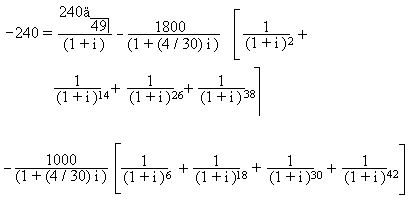
Annual percentage rate (I) = wi = .3204 = 32.04%
[Codified to 12 C.F.R. Part 226, Appendix J]
[Appendix J amended at 46 Fed. Reg. 29246, June 1,
1981]
{{4-28-95 p.6678.39}}
Appendix K to Part 226—Total Annual Loan Cost Rate
Computations
for Reverse Mortgage Transactions
(a) Introduction. Creditors are required to disclose a
series of total annual loan cost rates for each reverse mortgage
transaction. This appendix contains the equations creditors must use in
computing the total annual loan cost rate for various transactions, as
well as instructions, explanations, and examples for various
transactions. This appendix is modeled after Appendix J of this part
(Annual Percentage Rates Computations for Closed-end Credit
Transactions): creditors should consult Appendix J of this part for
additional guidance in using the formulas for reverse mortgages.
(b) Instructions and equations for the total annual loan cost
rate.
(1) General rule. The total annual loan cost rate
shall be the nominal total annual loan cost rate determined by
multiplying the unit-period rate by the number of unit-periods in a
year.
(2) Term of the transaction. For purposes of total
annual loan cost disclosures, the term of a reverse mortgage
transaction is assumed to begin on the first of the month in which
consummation is expected to occur. If a loan cost or any portion of a
loan cost is initially incurred beginning on a date later than
consummation, the term of the transaction is assumed to begin on the
first of the month in which that loan cost is incurred. For purposes of
total annual loan cost disclosures, the term ends on each of the
assumed loan periods specified in
§ 226.33(c)(6).
(3) Definitions of time intervals.
(i) A period is the interval of time between advances.
(ii) A common period is any period that occurs more
than once in a transaction.
(iii) A standard interval of time is a day, week,
semimonth, month, or a multiple of a week or a month up to, but not
exceeding, 1 year.
(iv) All months shall be considered to have an equal number of
days.
(4) Unit-period.
(i) In all transactions other than single-advance, single-payment
transactions, the unit-period shall be that common period, not to
exceed one year, that occurs most frequently in the transaction, except
that:
(A) If two or more common periods occur with equal frequency, the
smaller of such common periods shall be the unit-period; or
(B) If there is no common period in the transaction, the
unit-period shall be that period which is the average of all periods
rounded to the nearest whole standard interval of time. If the average
is equally near two standard intervals of time, the lower shall be the
unit-period.
(ii) In a single-advance, single-payment transaction, the
unit-period shall be the term of the transaction, but shall not exceed
one year.
(5) Number of unit-periods between two given dates.
(i) The number of days between two dates shall be the number of
24-hour intervals between any point in time on the first date to the
same point in time on the second date.
(ii) If the unit-period is a month, the number of full
unit-periods between two dates shall be the number of months. If the
unit-period is a month, the number of unit-periods per year shall be
12.
(iii) If the unit-period is a semimonth or a multiple of a month
not exceeding 11 months, the number of days between two dates shall be
30 times the number of full months. The number of full unit-periods
shall be determined by dividing the number of days by 15 in the case of
a semimonthly unit-period or by the appropriate multiple of 30 in the
case of a multimonthly unit-period. If the unit-period is a semimonth,
the number of unit-periods per year shall be 24. If the number of
unit-periods is a multiple of a month, the number of unit-periods per
year shall be 12 divided by the number of months per unit-period.
(iv) If the unit-period is a day, a week, or a multiple of a
week, the number of full unit-periods shall be determined by dividing
the number of days between the two given dates by the number of days
per unit-period. If the unit-period is a day, the number of
unit-
{{4-28-95 p.6678.40}}periods per year shall be 365. If the
unit-period is a week or a multiple of a week, the number of
unit-periods per year shall be 52 divided by the number of weeks per
unit-period.
(v) If the unit-period is a year, the number of full unit-periods
between two dates shall be the number of full years (each equal to 12
months).
(6) Symbols. The symbols used to express the terms of
a transaction in the equation set forth in paragraph (b)(6) of this
appendix are defined as follows:
Aj = The amount of each periodic or lump-sum advance to
the consumer under the reverse mortgage transaction.
i = Percentage rate of the total annual loan cost per
unit-period, expressed as a decimal equivalent.
j = The number of unit-periods until the jth advance.
n = The number of unit-periods between consummation and
repayment of the debt.
Pn = Min (Baln, Valn). This is the maximum
amount that the creditor can be repaid at the specified loan term.
Baln = Loan balance at time of repayment, including all
costs and fees incurred by the consumer (including any shared
appreciation or shared equity amount) compounded to time n at the
creditor's contract rate of interest.
Valn = Val0 (1 +  )y, where Valo is the
property value at consummation, )y, where Valo is the
property value at consummation,  is the assumed annual rate of
appreciation for the dwelling, and y is the number of years in the
assumed term. Valn must be reduced by the amount of any equity
reserved for the consumer by agreement between the parties, or by 7
percent (or the amount or percentage specified in the credit
agreement), if the amount required to be repaid is limited to the net
proceeds of sale. is the assumed annual rate of
appreciation for the dwelling, and y is the number of years in the
assumed term. Valn must be reduced by the amount of any equity
reserved for the consumer by agreement between the parties, or by 7
percent (or the amount or percentage specified in the credit
agreement), if the amount required to be repaid is limited to the net
proceeds of sale.
 = The summation operator. = The summation operator.
Symbols used in the examples shown in this appendix are defined as
follows:
FVxi = The future value of 1 per unit period for x unit
periods, first advance due immediately (at time = 0, which is
consummation).
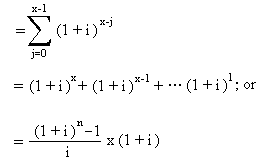
w = The number of unit-periods per year.
I = wi × 100 = the nominal total annual loan cost rate.
(7) General equation. The total annual loan cost rate
for a reverse mortgage transaction must be determined by first solving
the following formula, which sets forth the relationship between the
advances to the consumer and the amount owed to the creditor under the
terms of the reverse mortgage agreement for the loan cost rate per
unit-period (the loan cost rate per unit-period is then multiplied by
the number of unit-periods per year to obtain the total annual loan
cost rate I; that is, 1 =
wi):

(8) Solution of general equation by iteration
process. (i) The general equation in paragraph (b)(7) of this
appendix, when applied to a simple transaction for a
reverse
{{10-31-95 p.6678.41}}mortgage loan of equal monthly advances
of $350 each, and with a total amount owed of $14,313.08 at an assumed
repayment period of two years, takes the special
form:

Using the iteration procedures found in steps 1 through 4 of
(b)(9)(i) of Appendix J of this part, the total annual loan cost rate,
correct to two decimals, is 48.53%.
(ii) In using these iteration procedures, it is expected that
calculators or computers will be programmed to carry all available
decimals throughout the calculation and that enough iterations will be
performed to make virtually certain that the total annual loan cost
rate obtained, when rounded to two decimals, is correct. Total annual
loan cost rates in the examples below were obtained by using a 10-digit
programmable calculator and the iteration procedure described in
Appendix J of this part.
(9) Assumption for discretionary cash advances. If the
consumer controls the timing of advances made after consummation (such
as in a credit line arrangement), the creditor must use the general
formula in paragraph (b)(7) of this appendix. The total annual loan
cost rate shall be based on the assumption that 50 percent of the
principal loan amount is advanced at closing, or in the case of an
open-end transaction, at the time the consumer becomes obligated under
the plan. Creditors shall assume the advances are made at the interest
rate then in effect and that no further advances are made to, or
repayments made by, the consumer during the term of the transaction or
plan.
(10) Assumption for variable-rate reverse mortgage
transactions. If the interest rate for a reverse mortgage
transaction may increase during the loan term and the amount or timing
is not known at consummation, creditors shall base the disclosures on
the initial interest rate in effect at the time the disclosures are
provided.
(11) Assumption for closing costs. In calculating the
total annual loan cost rate, creditors shall assume all closing and
other consumer costs are financed by the creditor.
(c) Examples of total annual loan cost rate
computations.
(1) Lump-sum advance at consummation.
Lump-sum advance to consumer at consummation: $30,000
Total of consumer's loan costs financed at consummation: $4,500
Contract interest rate: 11.60%
Estimated time of repayment (based on life expectancy of a consumer
at age 78): 10 years
Appraised value of dwelling at consummation: $100,000
Assumed annual dwelling appreciation rate:
4%
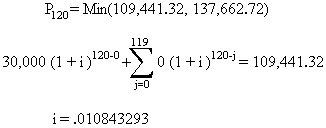
Total-annual-loan-cost rate (100(.1317069438 × 1)) = 13.17%
(2) Monthly advance beginning at consummation.
Monthly advance to consumer, beginning at consummation: $492.51
Total of consumer's loan costs financed at consummation: $4,500
Contract interest rate: 9.00%
Estimated time of repayment (based on life expectancy of a
consumer at age 78): 10 years
{{10-31-95 p.6678.42}}
Appraised value of dwelling at consummation: $100,000
Assumed annual dwelling appreciation rate:
8%

Total annual loan cost rate (100(.009061140 × 12)) = 10.87%
(3) Lump sum advance at consummation and monthly
advances thereafter.
Lump sum advance to consumer at consummation: $10,000
Monthly advance to consumer, beginning at consummation: $725
Total of consumer's loan costs financed at consummation: $4,500
Contract rate of interest: 8.5%
Estimated time of repayment (based on life expectancy of a consumer
at age 75): 12 years
Appraised value of dwelling at consummation: $100,000
Assumed annual dwelling appreciation rate:
8%

Total annual loan cost rate (100(.007708844 × 12)) = 9.25%
(d) Reverse mortgage model form and sample form.
(1) Model form.
Total Annual Loan Cost Rate
Loan Terms
Age of youngest borrower:
Appraised property value:
Interest rate:
Monthly advance:
Initial draw:
Line of credit:
Initial Loan Charges
Closing costs:
Mortgage insurance premium:
Annuity cost:
Monthly Loan Charges
Servicing fee:
Other Charges
Mortgage insurance:
Shared Appreciation:
{{10-31-95 p.6678.43}}

The cost of any reverse mortgage loan depends on how long you keep
the loan and how much your house appreciates in value. Generally, the
longer you keep a reverse mortgage, the lower the total annual loan
cost rate will be.
This table shows the estimated cost of your reverse mortgage loan,
expressed as an annual rate. It illustrates the cost for three [four]
loan terms: 2 years, [half of life expectancy for someone your age,]
that life expectancy, and 1.4 times that life expectancy. The table
also shows the cost of the loan, assuming the value of your home
appreciates at three different rates: 0%, 4% and 8%.
The total annual loan cost rates in this table are based on the
total charges associated with this loan. These charges typically
include principal, interest, closing costs, mortgage insurance
premiums, annuity costs, and servicing costs (but not costs when you
sell the home).
The rates in this table are estimates. Your actual cost may differ
if, for example, the amount of your loan advances varies or the
interest rate on your mortgage changes.
Signing an Application or Receiving These Disclosures Does Not
Require You To Complete This Loan
(2) Sample Form.
Total Annual Loan Cost Rate
Loan Terms
Age of youngest borrower: 75
Appraised property value: $100,000
Interest rate: 9%
Monthly advance: $301.80
Initial draw: $1,000
Line of credit: $4,000
Initial Loan Charges
Closing costs: $5,000
Mortgage insurance premium: None
Annuity cost: None
Monthly Loan Charges
Servicing fee: None
Other Charges
Mortgage insurance: None
Shared Appreciation: None
{{10-31-95 p.6678.44}}

The cost of any reverse mortgage loan depends on how long you keep
the loan and how much your house appreciates in value. Generally, the
longer you keep a reverse mortgage, the lower the total annual loan
cost rate will be.
This table shows the estimated cost of your reverse mortgage loan,
expressed as an annual rate. It illustrates the cost for three [four]
loan terms: 2 years, [half of life expectancy for someone your age,]
that life expectancy, and 1.4 times that life expectancy. The table
also shows the cost of the loan, assuming the value of your home
appreciates at three different rates: 0%, 4% and 8%.
The total annual loan cost rates in this table are based on the
total charges associated with this loan. These charges typically
include principal, interest, closing costs, mortgage insurance
premiums, annuity costs, and servicing costs (but not disposition
costs--costs when you sell the home).
The rates in this table are estimates. Your actual cost may differ
if, for example, the amount of your loan advances varies or the
interest rate on your mortgage changes.
Signing an Application or Receiving These Disclosures Does Not
Require You To Complete This Loan
[Codified to 12 C.F.R. Part 226, Appendix K]
[Appendix K added at 60 Fed. Reg. 15474, March 24, 1995,
effective March 22, 1995, but compliance is optional until October 1,
1995; amended at 60 Fed. Reg. 50400, September 29, 1995, effective
September 25, 1995]
{{12-31-96 p.6678.45}}
Appendix L to Part 226—Assumed Loan-Periods for Computations
of
Total Annual Loan Cost Rates
(a) Required tables. In calculating the total annual
loan cost rates in accordance with Appendix K of this part, creditors
shall assume three loan periods, as determined by the following table.
(b) Loan periods
(1) Loan Period 1 is a two-year loan period.
(2) Loan Period 2 is the life expectancy in years of the youngest
borrower to become obligated on the reverse mortgage loan, as shown in
the U.S. Decennial Life Tables for 1979-1981 for females, rounded to
the nearest whole year.
(3) Loan Period 3 is the life expectancy figure in Loan Period 3,
multiplied by 1.4 and rounded to the nearest full year (life expectancy
figures at .5 have been rounded up to 1).
(4) At the creditor's option, an additional period may be
included, which is the life expectancy figure in Loan Period 2,
multiplied by 5 and rounded to the nearest full year (life's expectancy
figures at .5 have been rounded up to
1).
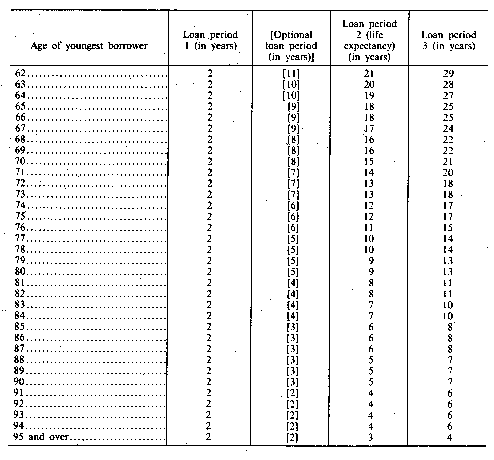
[Codified to 12 C.F.R. Part 226, Appendix L]
[Appendix L added at 60 Fed. Reg. 15476, March 24, 1995,
effective March 22, 1995, but compliance is optional until October 1,
1995]
[The page following this is 6685.]
*This is a margin we have used recently; your margin may be
different. Go Back to Text
**This is the amount of a discount we have provided recently; your
loan may be discounted by a different amount. Go Back to Text
[Main Tabs]
[Table of Contents - 6500]
[Index]
[Previous Page]
[Next Page]
[Search]
|